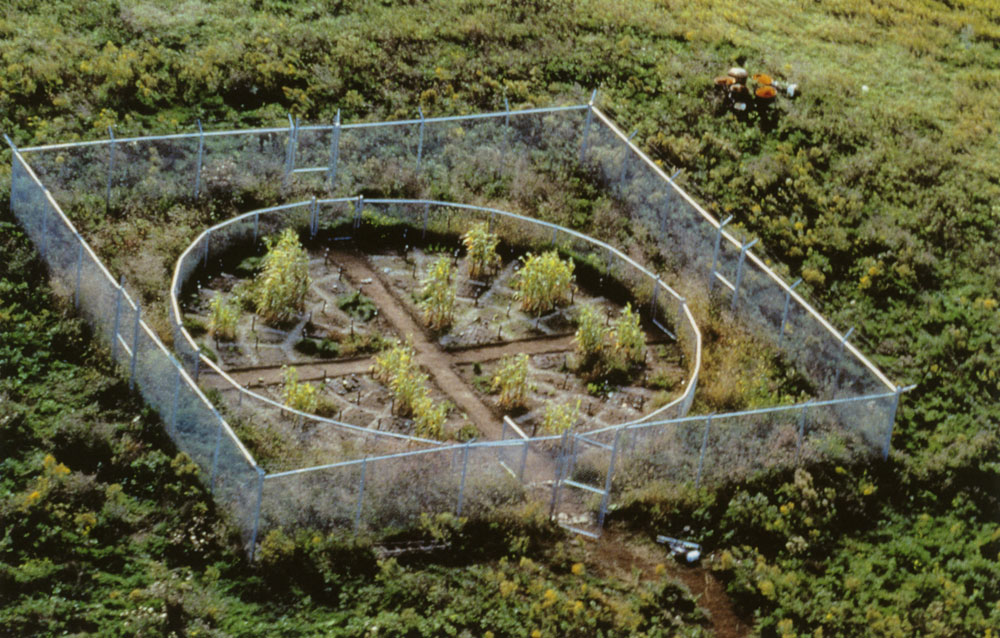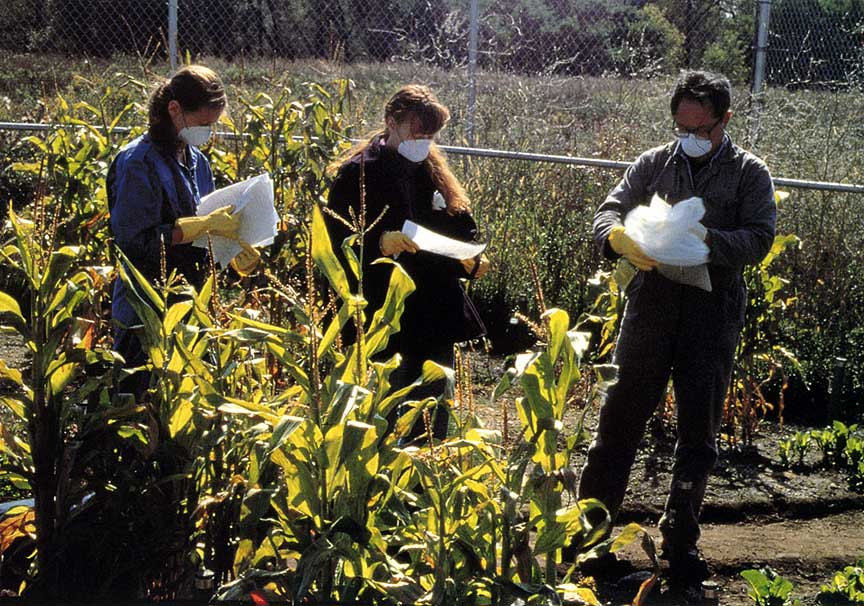Interview
“Revival Field”

Mel Chin. Revival Field, 1991. Pig’s Eye Landfill, St. Paul, Minnesota. Plants, and industrial fencing on a hazardous waste landfill; approximately 60 x 60 x 9 feet. Courtesy of the artist.
Artist Mel Chin discusses the inspiration for his 1991 land art piece, Revival Field.
ART21: How did you develop the idea for Revival Field?
CHIN: It was funny stumbling on the idea. It was in the Whole Earth Review. It was written by a psilocybin expert, Terrence McKenna, who has his own cult following and has written interesting things on ethnobiology. He was writing about the possible cleaning of toxic ground with the plant datura. It was like in the film The Graduate—you know the guy, not Dustin Hoffman—but I was the guy telling Dustin Hoffman, “Plastics, it’s plastics, it’s the future!” I ran to see my wife (or girlfriend, then) and just told her. I said, “It’s plants. The future is plants. The new sculpture is plants.” Most of my friends thought I was a little bit insane because: number one, you quit, you had a show, and you’re going, your career is starting; and now, you quit, and you’re now talking about plants? And I saw the poetic nature of this. I said, “It is a sculpture. It could be a sculpture of carving away.”
And put it this way: I say that it’s the traditional sculpture that I’m interested in. Michelangelo has his Carrara marble; he has an idea, an image. And he goes with his chisels and he creates David, and we all “Ooh!” and “Ahh!” over it, and whatever we do in front of it. That’s it. Now, I’m in a world where I open up the paper; I read these articles. We live in a world of pollution with heavy metals saturating the soil, where there is no solution to that. If that [pollution] could be carved away, and life could return to that soil and then a diverse and ecologically balanced life, then that is a wonderful sculpture. I think there is a profound aesthetic in there, and it’s really simple. But we have to create the chisels, and we have to create the tools, and we have to isolate the problem: where the block of pollution is, so we can carve it away. It became very clear to me that it (Revival Field) would be a sculptural project worth engaging in. And I set upon to finding out more, whether datura could do this—jimsonweed is common.
ART21: Datura is jimsonweed?
CHIN: Yeah. And so, I’d gone through all the conceptual workings of this; now I just needed to take the poetry of this idea and turn it responsibly and pragmatically into reality. I found this landfill expert at Texas A&M, who said, “Well, I have no knowledge of datura ever doing that, but I heard a paper by a guy named Rufus L. Chaney. And he’s in Beltsville, Maryland; he’s a research scientist who gave a paper about plants and accumulation, and we’re talking about hyperaccumulation.” Hyperaccumulation is this notion that the plants can suck up so much metal—and we’re talking about heavy metals, not everything—that the plant itself was 20 to 40 percent heavy metal when you ashed it. So, you could sell it as an ore and pay for this process. Because it’s not just enough to pull it up—you have to think about the whole machinery, a reality.
You have to create a condition for an idea to survive. It’s like creating an economy to make it worthwhile to promote. I had to see the big picture of things. If you say, “Okay, this has to be completed after I’m dead,” then what do you need to do to make it work? It has to be self-sustaining. It has to prove itself to be self-sustaining. So, I called Dr. Chaney up, and here’s Dr. Chaney saying, “Well, datura will get you high, but if you want to suck up heavy metals, you’ve called the right person.” He said, “Everything I’m doing is on the shelf. There is no support within our government at this time (a conservative government at the time) to go into this kind of research. I’m back working on sewage sludge.” But his passion was, he said, “this thing I really care about”—clearing heavy metals from soil. And I said, “Well, what if I have this idea, and you have this idea. Let me learn about the science behind it, and maybe we could work together, so we can do what you need.” And he said, “What I really need is a replicated field test. If you can do this, then we’ll be able to make science, because science is in the lab.” We had to make the artwork create the science.

Mel Chin. Revival Field, 1991. Pig’s Eye Landfill, St. Paul, Minnesota. Photo documentation of the first harvest on a State Priority Superfund Site. Courtesy of the artist.
ART21: What is a replicated field?
CHIN: It’s going somewhere in the world outside the lab—like throwing a dart on the board—to do an experiment that you did in the lab (that shows that there is heavy metal transfer into a plant), and then go randomly to a hostile climate, in the field, do the planting, and show there’s results that match what’s in the lab. So, it’s replicated by a control. So I felt like, “Why not?” And then the art can mutate into a science project dedicated to providing the world this information, good or bad. And I was already projecting that the physical structure was not important, that, you know, this physical manifestation of the field and all this is also evolutionary—it’s a temporary thing. It’s more about this field being transformed by the science and living again or creating an idea that survives in the world. So, all this was conceived and understood, and I went about doing the very difficult negotiations, where every day I would be on the phone, borrowing money if I had to, to pay the phone bill, or writing letters or do whatever—doing anything necessary to get this artwork together.
And it’s funny, when people are used to seeing you making sculpture or creating drawings, and they come in, and you’re on the phone constantly, and they say, “Well, aren’t you going to make any art today?” And I would say, “I am making art. This is it.” Because I was driven by that and meeting tremendous obstacles that were not just about the science and not just about the art. There were legal obstacles that occurred, where people said, “Well, we don’t want to talk about it anyway, because it’s about financial responsibilities for the pollution, and we have got to say we didn’t do it.” So, all these things I learned about the politics. “Why? You know it doesn’t make sense,” I said, “Why are we living in a ground like Love Canal? Why are we living in areas that are . . . are toxic? And why are people allowed to be there? And why isn’t there someone who’s responsible?” And obviously there’s political corruption where money is just wasted, and there are things that just don’t make any sense. I learned that they do make sense in a way that is about the terrible aspects of human nature, and that’s the truth.



